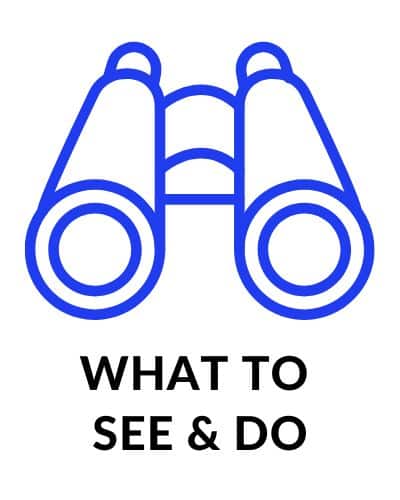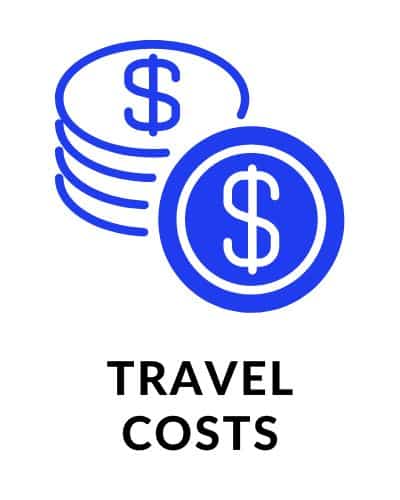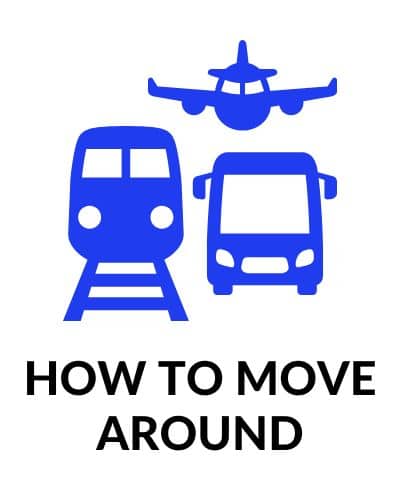Albania is a unique and special country in Europe. Its laid-back lifestyle is distinct from other developed and organized European nations, making it unique. Backpacking through Albania should be on every adventure seeker’s bucket list.
While backpacking in Albania, you’ll encounter friendly locals leading simple lives, idyllic beaches perfect for relaxation, charming historic villages, mountains to hike, and numerous other opportunities to immerse yourself in the Albanian way of life.
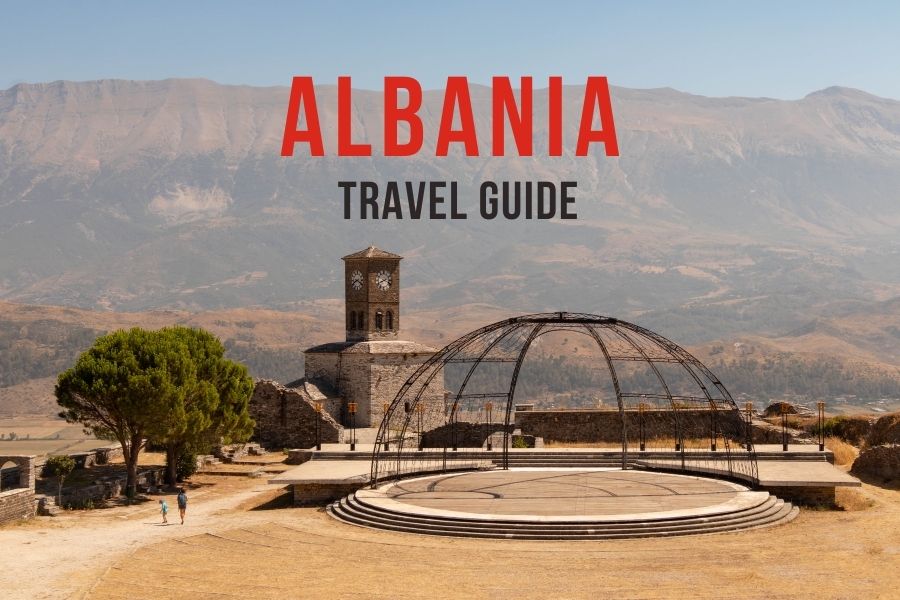
Disclosure: This article features affiliate links, including Amazon.com. If you decide to buy through one of these links, I’ll earn a small commission at no extra expense to you. For more details, please see my disclosure policy.
What can you learn from this backpacking Albania travel guide?
I will show you the best places to visit in Albania, provide approximate travel costs, explain how to enter and navigate around Albania, offer travel tips for exploring on a budget, give an average daily budget, teach you how to say “hello” in Albanian, and much more.
Quick Facts About Albania
- Language: Albanian.
- Currency: Albanian lek (L).
- Capital: Tirana.
- Population: 2.9 mln (2021).
- Highlights in Albania: historic villages, Albanian Riviera, Theth National Park.
- Fun fact about Albania: More Albanians live outside than inside the country.
Things to Do and See in Albania
Albania is a diverse country with many historic sites, sandy beaches, mountains, charming villages, and unique traditions.
1. Explore the stone city Gijrokaster
Gjirokaster, located south of Albania, is an Ottoman-era city known as the Stone City. It is primarily recognized for its charming old town.
Strolling through the UNESCO World Heritage-designated Old Town streets, exploring artisan shops in the Bazaar, admiring views from the Gjirokaster Castle, and visiting fascinating museums are some activities to enjoy in Gjirokaster’s Stone City.
Gjirokaster is a must-visit location in that captivating country. It boasts a wealth of well-preserved history, complemented by a laid-back lifestyle and friendly residents.
2. Soak in Benja Thermal Baths
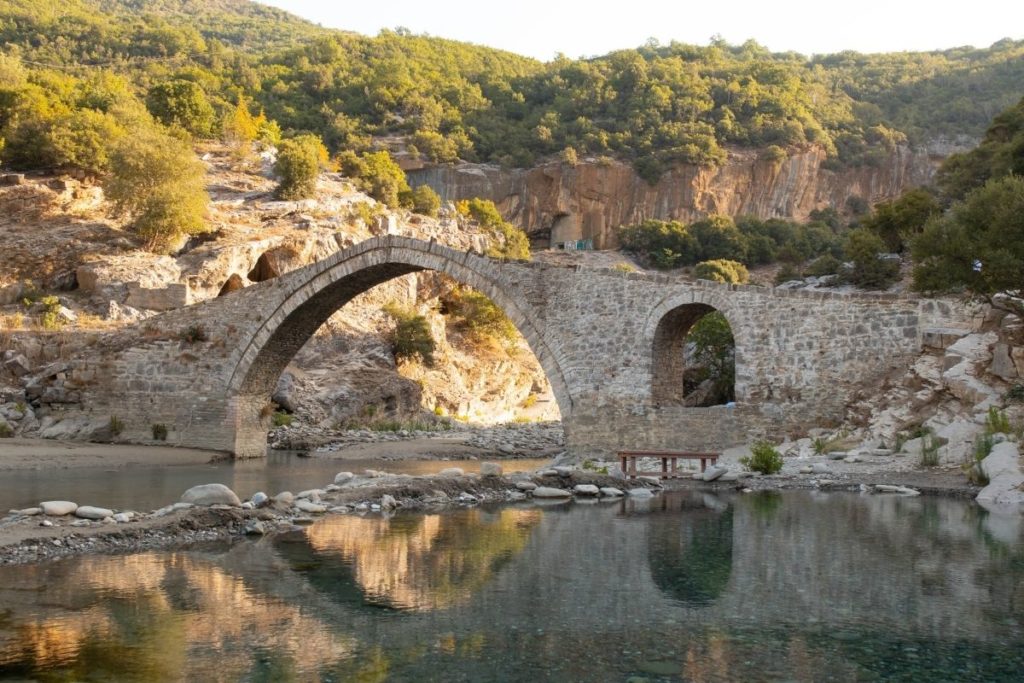
The Benja Thermal pools are situated off the main roads, nestled in a beautiful natural area. The road leading there is accessible by any car. Once there, you’ll find several man-made pools where the geothermal water maintains a temperature of around 30 degrees Celsius throughout the year.
It’s a serene camping area, and you’ll often encounter other campers who appreciate the natural surroundings. The location is easily identifiable by a picturesque, iconic Ottoman-era bridge. Additionally, you can hike along the gorge to discover scenic spots, including some waterfalls.
3. Blue waters at Ksamil

The most popular beach vacation spot in Albania is Ksamil, often called their “pearl.” With its turquoise waters and beautiful beaches, it’s an ideal location for leisurely sunbathing. However, it’s important to note that it becomes extremely crowded during the high season.
This Mediterranean gem marks the beginning of the Albanian Riviera. The primary activity here is to relax on the pristine, sandy beaches that resemble paradise. You can unwind or engage in activities like jet skiing, paddling on a SUP board, scuba diving, and more.
The location is also ideal, near the larger city of Sarande and the historic Butrint National Park.
4. Stroll around Butrint National Park
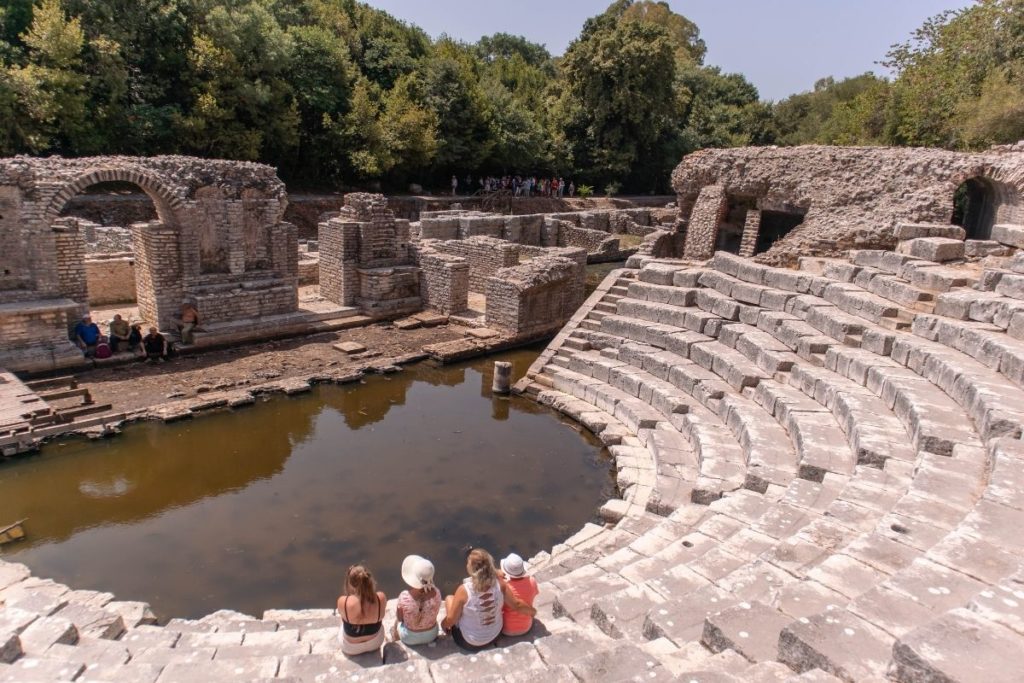
Butrint National Park is situated near the picturesque beach town of Ksamil. It holds significant importance in Albanian history and is a must-visit.
Within the park, you can discover ruins such as the Roman Theatre, Roman Baths, Gymnasium, Fountain of the Nymphs, The Great Basilica, and the Lion Gate. The Venetian Castle is exceptionally well-preserved, and within it, you can delve into the history of that powerful civilization at the Archaeological Museum.
Beyond its historical ruins and sites, the park is a stunning natural destination. It’s enveloped by water and captivating hills, making it a delightful place for a stroll.
5. Party at Sarande
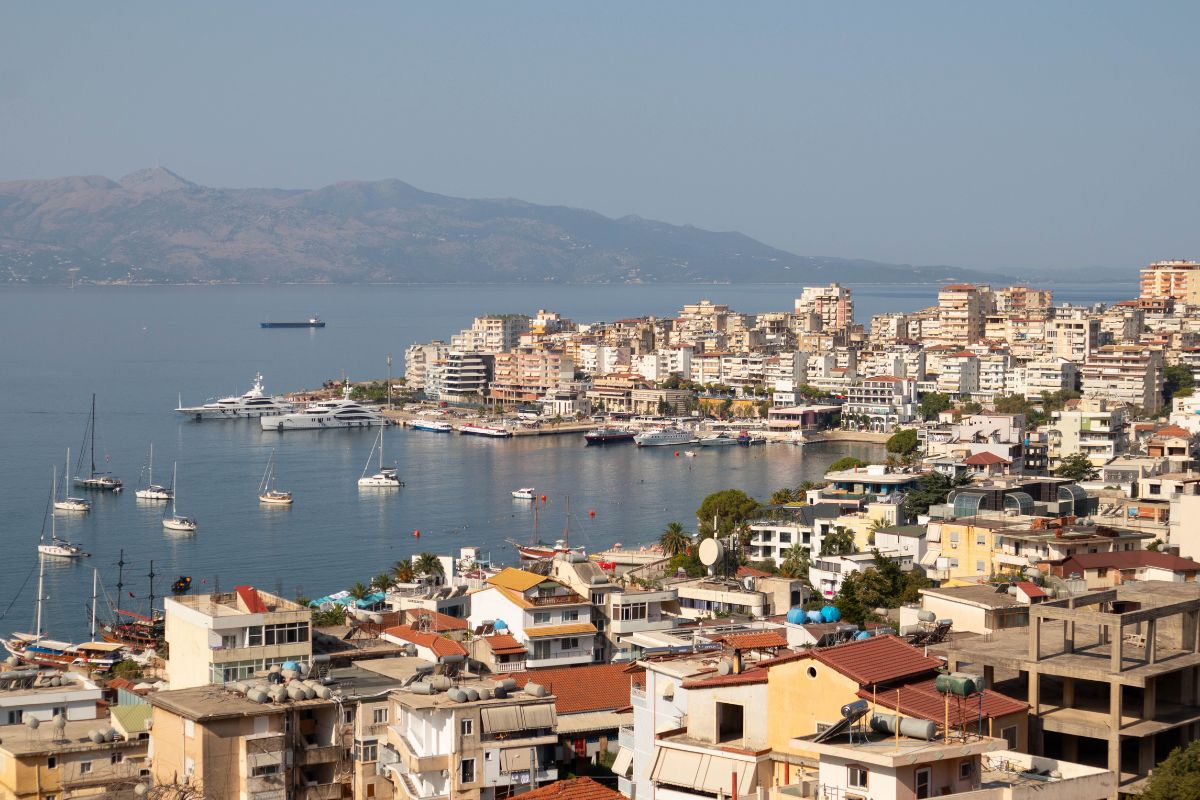
Sarande is situated near the Greek border in southern Albania. Its popularity grows yearly, establishing it as a key destination along the Albanian Riviera coastline.
Like its neighbor Ksamil, Sarande is a sought-after summer destination for beach holidays. While the city may not boast as many pristine beaches as Ksamil, it offers a more diverse range of activities. There’s a vibrant atmosphere with parties, cruises, restaurants, and other live events.
This location is also renowned as Albania’s primary hub for summer parties. Numerous party venues line the seaside, and there are even boats that host nighttime festivities.
6. Berat – the City of a Thousand Windows
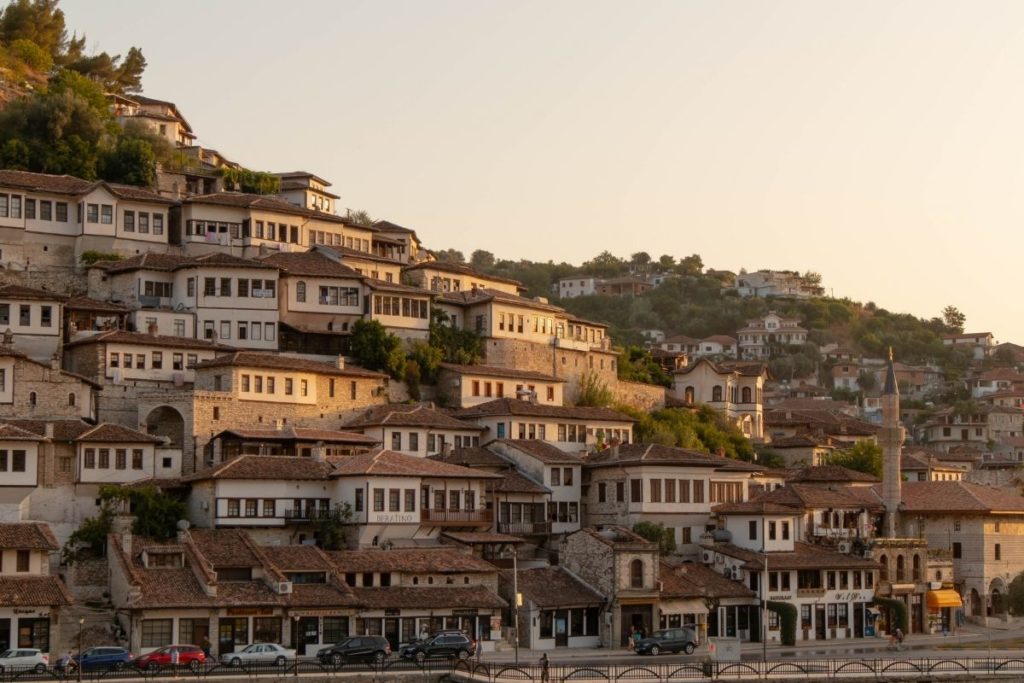
Berat is a primary and highly recommended destination to explore in Albania. Often referred to as the “city of a thousand windows,” it’s a place that shouldn’t be missed.
This UNESCO World Heritage city is celebrated for its distinctive architectural style. The Gorica and Mangalem neighborhoods are ideal spots to meander through the historic town. Atop the Mangalemi quarter sits a castle, offering panoramic views of picturesque Berat.
7. Seek the modern Tirana
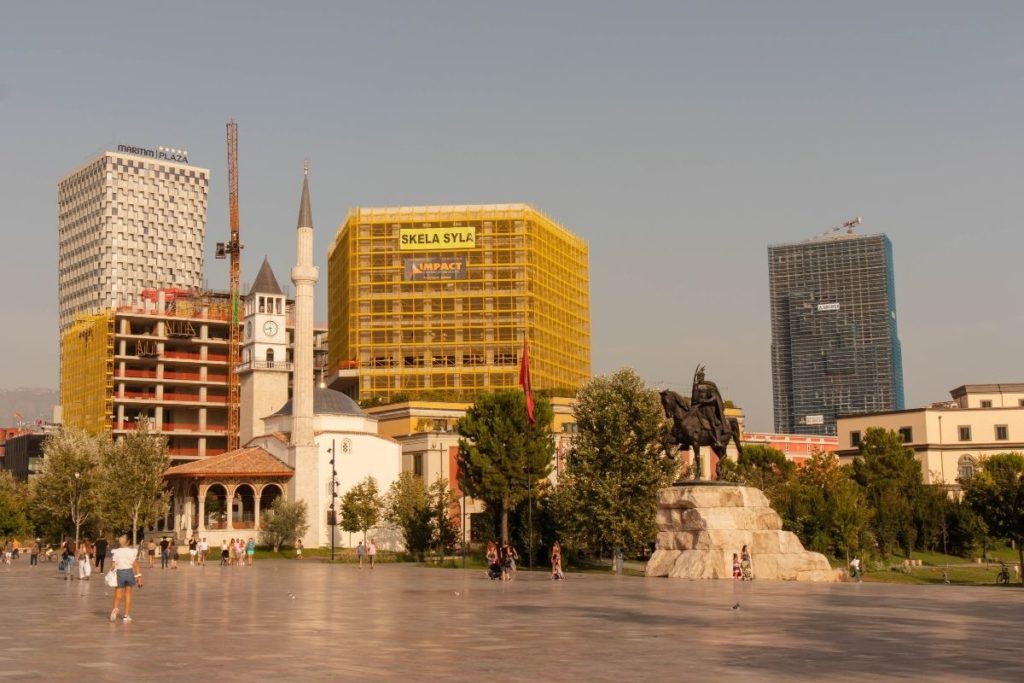
Tirana is Albania’s capital and home to about one-third of the country’s population. It’s far more organized and developed than many other low-key locations in the country.
Surprisingly, Tirana is a vibrant city with a beautiful city center, live events, and numerous attractions. In Albania’s capital, notable sites include Skanderbeg Square, the Et’hem Bej Mosque, the Pyramid of Tirana, the Resurrection of Christ Orthodox Cathedral, the primary market in the Bazaar, and more.
One must-visit attraction in Tirana is the Bunk’Art underground tunnels. Located in the suburbs of Tirana, visitors can wander through the tunnels and delve into its intriguing history.
Also, if you are looking for a day hiking trip, Mount Dajti is an ideal option. It is easily reachable via the Mount Dajti cable car, and from the top, you can see amazing views of Tirana.
8. Hike between Valbona and Theth
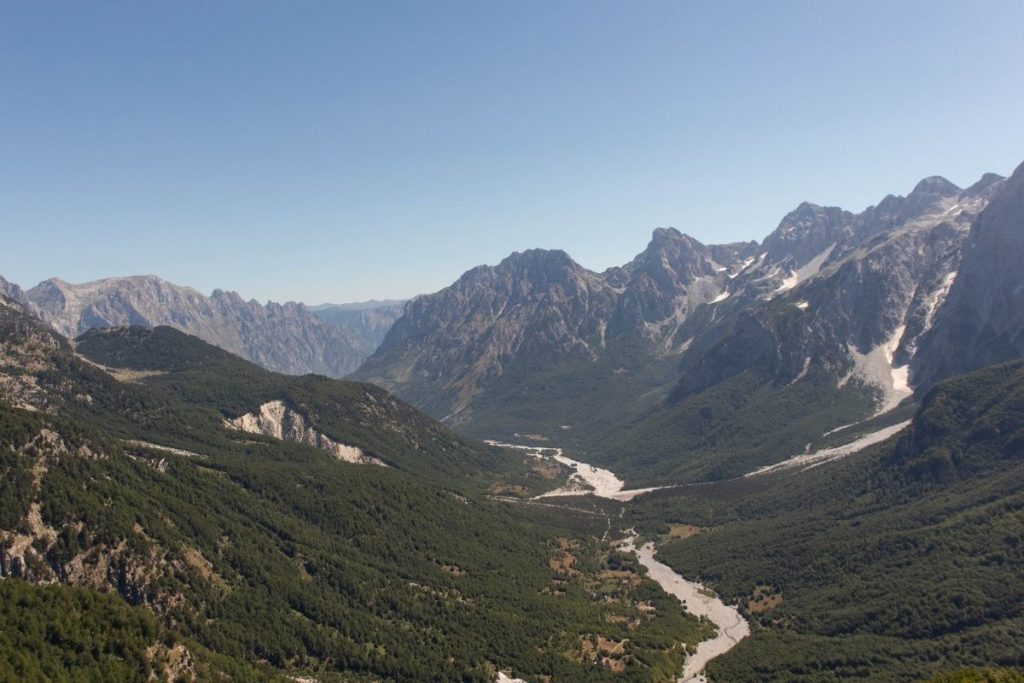
One of the main things to do in Albania is hiking through the picturesque Theth National Park. While several trails are available, the most scenic and famous is the hike between the mountain villages of Theth and Valbona.
The renowned trail spans 12 km and typically takes 6 to 9 hours. It’s a moderate hike with a peak elevation of 1800 meters. The path is manageable in both directions, and there’s no need for specialized hiking equipment.
The route is predominantly scenic, offering breathtaking views of the Valbona Valley and the Albanian Alps. Along the way, there are several huts where you can rest and indulge in cold beverages and warm meals.
Read more: Best hikes in Albania.
9. Cross the Ali Pasha bridge

The Ali Pasha Bridge was originally part of a more extensive aqueduct system built in the early 19th century. Today, despite no water present, the picturesque canyon and bridge are reminders of the past.
The bridge is renowned because it has been, and continues to be, used by shepherds guiding their herds. They usually cross the bridge approximately an hour before sunset. Even if you miss seeing the shepherds in action, the location is still stunning. Plus, it’s only a 30-minute walk from Gjirokaster’s center.
10. Take a ferry on Komani lake
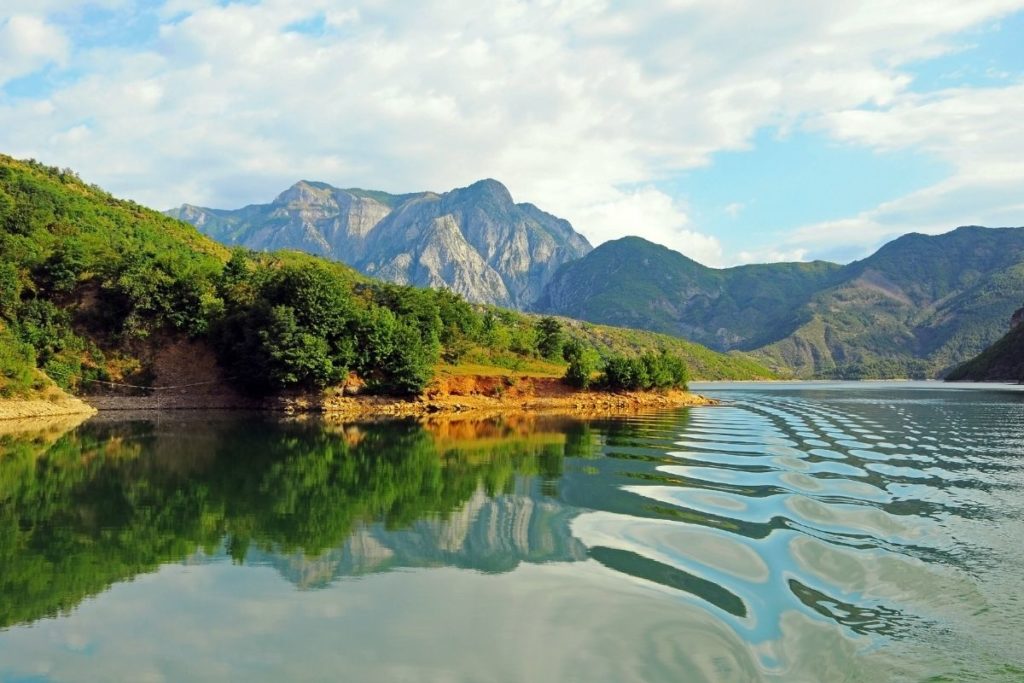
Close to Theth National Park is another attraction popular among wandering tourists. A ferry ride from Komani to Firenza (and vice-versa) lasts about 2.5 hours, taking you through a stunning valley.
This exceptional journey is one of the primary activities to experience in northern Albania. You can incorporate this activity while backpacking through Theth National Park in Albania.
The most convenient route in northern Albania involves taking a bus from Shkoder to Komani. From there, you can catch a ferry to Firenze, which operates twice daily. Upon arrival, you can board a shuttle bus to Valbone, hike to Theth, and then return to Shkoder by bus. This trip typically spans 2 to 3 days. Alternatively, you can undertake the entire journey in the reverse order.
11. A quick dip at Blue Eye

Albania boasts two “Blue Eyes.” One is between Sarande and Gjirokaster, while the other is near the Theth village in the north. The Blue Eye near Sarande and the one near Theth are popular among visitors.
The latter is approximately 10km from the heart of Theth village and requires about a 2-hour walk one way. If you’re fatigued after a long hike, you can opt for a taxi from Theth to Nderlysaj.
The hike from Theth to the Blue Eye is truly remarkable. You can venture on longer hiking trails, stroll alongside pristine valley rivers, discover waterfalls, and soak in the natural beauty. Taking a refreshing dip in the crystal-clear Blue Eye is a must-do while backpacking in Albania.
Additionally, if you find the renowned mountain village too bustling and seek a quieter experience, consider alternatives to Theth, like the villages of Razëm and Bogë.
12. Hike around Lake Bovilla
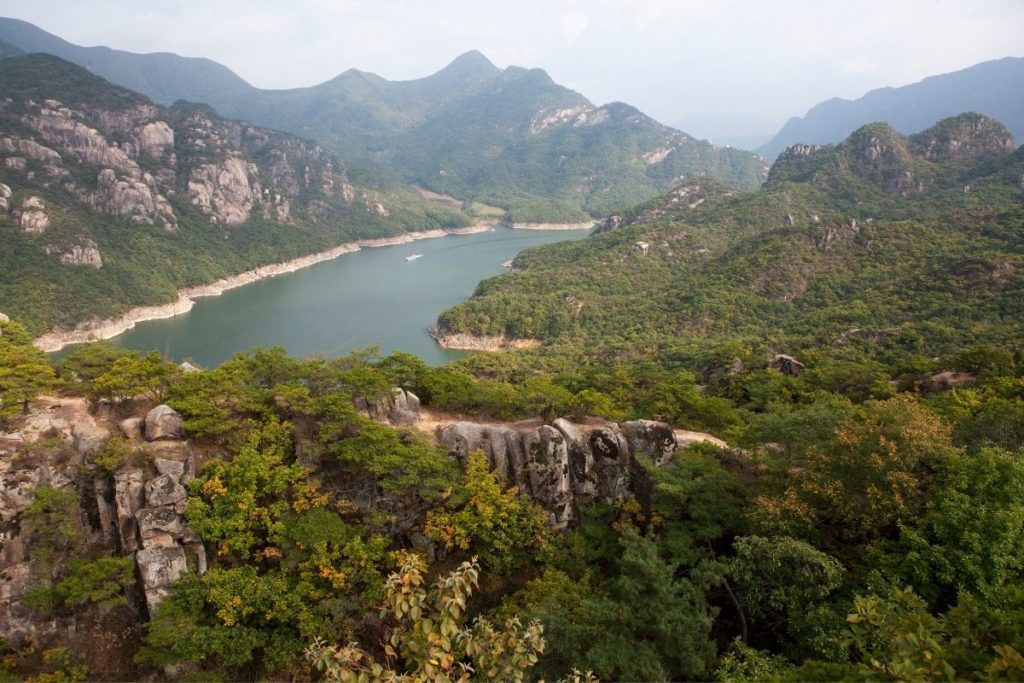
If you wish to explore beyond the capital, Lake Bovilla Reservoir is a mere 15 km from Tirana and an ideal day trip destination. Around 50% of Tirana’s potable water is sourced from this reservoir.
Given that the Lake Bovilla area is mountainous, it offers excellent hiking and mountain climbing opportunities. The most popular hiking trail leads visitors to Gamti Mountain, where one can marvel at the hues of the water and the surrounding mountains. The entire trail takes approximately 2 hours and is of moderate difficulty.
13. Drive through the Llogara Pass
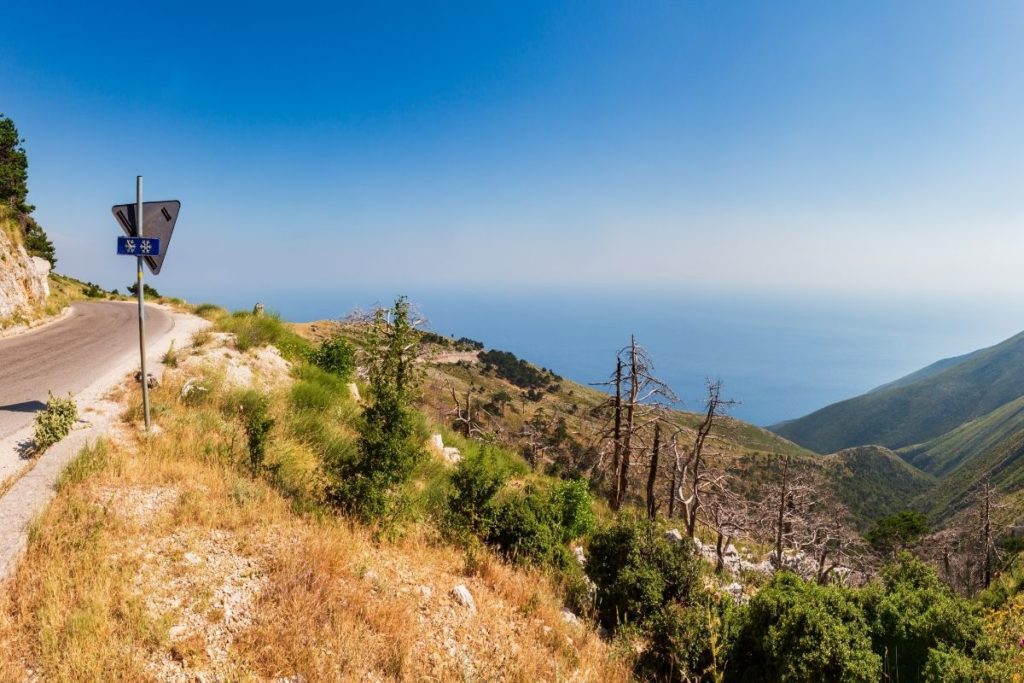
In the south of Albania, adjacent to the Ionian Sea, lies Llogara National Park, one of the most visited destinations in the country. This picturesque natural haven offers trails and stunning mountains and sea views.
The roadway through the National Park, also known as the Llogara Pass, winds along the coast. It’s a winding mountain road that offers views of the stunning natural landscape and the beautiful Ionian Sea. The road itself spans approximately 23 km, with its highest point reaching an elevation of 1,043 meters above sea level.
14. Himarë and the Albanian Riviera
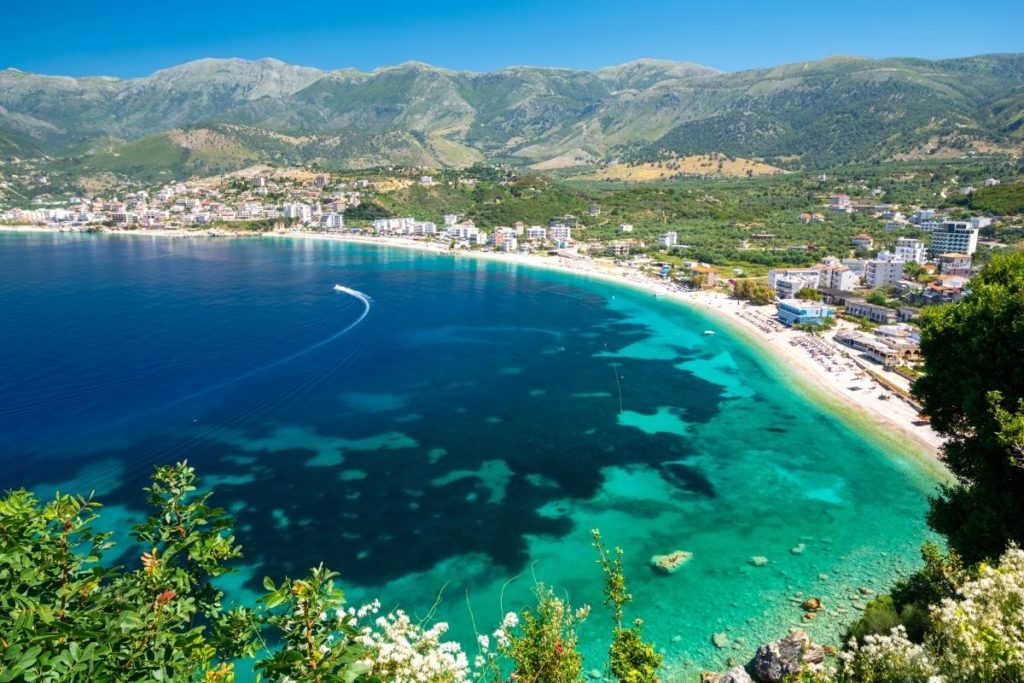
Himare is a quaint location in Albania where you can experience all that the Albanian Riviera coastline has: a deep blue sea, abundant beaches, and a laid-back vibe. It has everything you need for a seaside holiday.
From Himare, you can discover several beaches for sunbathing, restaurants offering local seafood dishes, hiking paths for nature walks, and boat trips to cruise the waters of the Albanian Riviera. Himare is an ideal getaway from the hustle and bustle of daily life, providing a perfect setting for relaxation.
15. Pogradec and Lake Ohrid

Pogradec is a city situated along the shores of the iconic Lake Ohrid. This laid-back city is a delightful place to stay, thanks to the hospitality of its residents. While there, you can visit the Pogradec Castle, the nearby Kamje rock, and the beautiful Lake Ohrid.
Scenic Lake Ohrid is the deepest lake in the Balkans. UNESCO also protects it due to its rich flora and fauna. The lake is home to several rare species, including the Koran fish. Lake Ohrid is a magnificent natural attraction you shouldn’t miss on your backpacking trip through Albania.
16. Adventure at Osumi Canyon

Osumi Canyon is another natural marvel in Albania, boasting stunning gorge formations, hiking paths, and adventure activities. It’s situated near the historic city of Berat and is often visited as a day trip from there.
You can find activities and sights from this location to fill an entire day or even more. You can admire the canyon from the “Bride’s Hole” viewpoint and swim near the “Ura E Vjeter E Zaberzanit” bridge, among other attractions.
During the summer, when the water level in the canyon river is lower, you can walk alongside the river down the gorge trails. In the spring months, when the river is fuller, there are ample opportunities for rafting tours.
17. Krujë – The home of national hero
The hometown of the national hero, Skanderbeg, is rich in history and offers many exciting places to see. This charming mountain village is situated about 30 km north of the capital.
In Kruje, you can delve into the history of the national hero at the Skanderbeg Museum, wander around Kruje Castle, visit Dolma Teqe, and shop for crafts at the Kruje Bazaar, among other activities. It’s a village where you’ll encounter hospitable residents, abundant craftsmanship, and a delightful village ambiance.
18. Sazan Island – An old military base

For years, the largest island of Albania remained a mystery because it was not open to tourists. Now accessible, the island reveals abandoned structures and old military buildings. Sazan Island’s primary purpose was to withstand nuclear attacks.
Although it has been opened to tourism, it still functions as one of Albania’s military bases. Yet, most buildings, bunkers, and tunnels have remained untouched and inactive for years. This “secret” island, accessible from Vlore, should be on your itinerary when backpacking through Albania.
19. Keep counting endless bunkers
From the 1960s to the 1980s, over 170,000 concrete bunkers were constructed throughout Albania. A local “leader” believed that with these bunkers, they could defend against powerful nations. However, these bunkers never served their intended purpose.
Today, these bunkers remain, with most of them abandoned. They can be found in every region, including within cities. So, what can be done with so many bunkers? For instance, Keq Marku decided to open a tattoo studio inside one of them.
Read more: Unique things to do in Albania.
Backpacking Albania Travel Costs
Albania is one of the poorest countries in Europe. As a result, it’s an incredibly affordable destination for travelers. The country has its currency: the Albanian LEK.
It’s advisable to withdraw significant cash, as many businesses do not accept card payments.
Accommodation Costs
Hostels are your best accommodation option if you’re backpacking through Albania on a budget. There are plenty of them in the main tourist destinations of Albania. Budgeting 10 – 15 € for a bed in a shared dorm per night during the high season should suffice. Often, breakfast is included in this price.
Hostel prices can drop below 10 € per night in various parts of Albania. Remember that most hostels prefer cash payments.
If you value privacy, budget hotel prices start at approximately 30 € per night for two during the peak season.
The towns along the Albanian Riviera and Theth National Park (Theth and Valbone) are among the pricier areas. As popular tourist destinations, expect to pay more in these locations.
Food Costs
Like much of the Balkans, Albanian cuisine tends to be heavy, featuring various meat dishes. A typical main course is quite substantial. Even when you add a dessert, such as crepes, and a drink, the total often remains around 10 – 15 € in mid-range restaurants.
Restaurant prices are remarkably affordable throughout Albania. For instance, a Margherita pizza typically costs between 4 and 5 €. A beer at a bar ranges from 1.5 to 2.5 €, and a meat-centric main dish can be as low as 5 € (6 $) or even less.
For those on the go, Albanian street food offers options like hamburgers and gyros, priced around 2 – 3 €, with generous portion sizes.
Again, keep in mind that prices can be much higher during the peak season and in high tourist zones. However, if you venture away from these areas, you’ll find more affordable places to eat.
Attraction Costs
In mainland Albania, popular attractions include castles, national parks, and other historical sites. Most castle visits cost around 5 €.
Along the Albanian coast, you’ll find activities related to the sea, such as yacht cruises, kayak rentals, SUP boards, jet skis, and other water activities. Prices fluctuate based on location, with the southern areas of Sarande and Ksamil being among the more expensive.
How to Get Around Albania
While Albania may not have a well-developed transportation system, its airport in Tirana is among the busiest in the Balkans. There are both convenient and adventurous ways to travel throughout the country.
How to travel to Albania
If you’re flying into Albania, your primary option is the main international airport in the capital, Tirana. It is one of the busiest airports in the Balkans, offering connections to cities like London, various cities in Italy, Vienna, Istanbul, Frankfurt, and many more. You can check flight schedules and availability on Kiwi.
Another option is to approach Albania via ground-based public transport. Surrounding Albania are several popular routes serviced by Eurail trains and various buses. You can check schedules on Omio. However, it’s important to note that trains aren’t a viable option within Albania due to poor connections.
Being a coastal country, Albania can also be reached by boat. The most common routes are between Corfu (Greece) and Sarande, as well as between Bari (Italy) and Durres.
How to Get Around Albania
Backpacking through Albania is an exciting adventure. You can navigate the country safely and swiftly by renting a car, using local public transport, or even trying your hand at hitchhiking.
Public Transportation
Both locals and budget-conscious travelers frequently use public transport. Buses and “furgons” are the most common modes of transportation. Buses typically operate between major destinations and cover longer distances, while furgons cater to a different niche.
Furgons are privately owned, unlicensed vehicles. They primarily service routes between villages, and these minibusses are often filled. Traveling in a furgon offers a unique and enjoyable experience for those backpacking through Albania.
Renting a car in Albania
In many places, renting a car is the most convenient (though often the most expensive) way to travel around Albania. This allows you to stop wherever you wish, visit locations not accessible by public transport, and save time on the move. You can find rental options on Rentalcars.
Hitchhiking in Albania
Another option is hitchhiking if you’re on a tight budget and can’t afford a car rental.
Hitchhiking is extremely popular in Albania, even among locals. It’s an unofficial yet standard mode of transportation in this unique country. The people are friendly, and typically, you won’t have to wait long before someone offers you a ride. Check out tips for hitchhiking in Europe.
Where to Stay In Albania on a Budget
- Trip’n’Hostel – Tirana
- The English Hostel – Tirana
- The Wanderers Hostel – Shkoder
- Mi Casa es Tu Casa – Shkoder
- Saranda (SR) Backpackers – Saranda
- Himara Downtown Hostel – Himare
- Berat Backpackers Hostel – Berat
- Hostel Durres – Durres
- Stone City Hostel – Gjirokaster
- Vlora Backpackers Hostel Seaside – Vlore
Daily Budget for Backpacking Albania
Albania is among the most affordable countries in Europe. The costs of accommodation, transport, food, and other leisure activities are significantly lower than the average European prices.
Like everywhere in Europe, prices can vary between high and low seasons. It’s also worth noting that when backpacking through Albania, you’ll encounter higher prices in areas like the Albanian Riviera and around Theth National Park.
Budget travelers should aim to spend around 20 € per day in Albania. With this budget, you can stay in a basic hostel, try Couchsurfing, or even a wild camp. Prepare your meals or indulge in street food like gyros. Many cities and tourist spots are best explored on foot. Consider using public transport or hitchhiking for longer distances as you backpack around Albania.
A backpacker looking for more comfort should budget around 30 € per day. With this amount, you can stay in a decent hostel, savor the Albanian cuisine in local restaurants, and occasionally enjoy street foods like gyros. This budget also allows for using standard public transportation and entry to some attractions while exploring Albania.
A mid-range traveler desiring even more comfort and the privacy of their room should budget approximately 50 € per day. While backpacking through Albania with this budget, you can secure a private room in a mid-range hotel, dine in local restaurants, use public transport, and visit attractions daily.
| Housing | Food | Transport | Attractions | Daily Budget | |
| Tight budget | 0 – 10 € | 10 € | 0 – 5 € | 0 – 5 € | 10 – 30 € |
| Backpacker | 10 € | 10 € | 5 € | 5 – 10 € | 30 – 35 € |
| Mid-range | 20 – 30 € | 15-20 € | 5 € | 10 € | 50 – 65 € |
Albanian Language
It’s always beneficial to familiarize yourself with basic phrases and words in the local language of the place you’re visiting. While overall, places have many English speakers, they might be scarce in some areas. Thus, grasping essential local words and phrases can be handy. While Albanian can be challenging to learn, below are some basic phrases and words to get you started:
- Hello! – Përshëndetje!
- How are you? – Si jeni?
- I’m fine – Un jam mir
- Thank you! – Faleminderit!
- Yes – Po
- No – Jo
- You’re welcome – Ju lutem!
- Have a nice day – Ditën e mirë!
- Excuse me – Më falni
- How much is it? – Sa kushton?
- Cheers! – Gëzuar!
- Do you speak English? – Flisni Anglisht?
Best Time to Visit Albania
The ideal time to visit Albania largely depends on what you’re seeking. Weather-wise, the most favorable period spans from May to early October. The peak season falls in July and August, perfect for beach vacations, but this is also when prices surge.
For backpackers, the optimal times to explore Albania are the shoulder seasons: from April to June and from September to the beginning of October. These months typically see fewer tourists, allowing more space on beaches, in cities, and at various sites. Additionally, prices tend to be more reasonable. During these periods, temperatures generally hover around 20 degrees Celsius (68 Fahrenheit) or higher.
In truth, there’s no “wrong time” to backpack through Albania. If you aim to experience the entirety of Albania, including all its attractions, beach lounging, and hiking, then the months approaching summer are ideal. However, it’s advisable to visit during the off-season months for shorter getaways and exploration of intriguing cities like Tirana, Berat, and Gjirokastër.
Albania Visa Requirements
Visiting Albania as a tourist is similar to visiting any other European country. While it’s not part of the European Union or the Schengen Area, entry typically involves a brief passport check. Tourists are permitted to stay for up to 90 days. However, gathering more detailed information about Albanian visa requirements is wise before planning a backpacking trip.
Is Albania Safe to Travel?
Albania isn’t your typical European tourist destination. It sees fewer visitors, and many from other countries aren’t familiar with the region or its inhabitants. Like much of the Balkans, Albania might suffer from a somewhat tarnished reputation influenced by media portrayals. Yet, your perspective will likely shift once you experience this unique country.
Albanians are among the most hospitable, friendly, and welcoming people I’ve ever encountered. They’re genuinely interested in foreigners and strive to offer visitors an unparalleled experience through their exemplary service. As with any destination, it’s essential to approach your travels with an open mind and always exercise common sense.
Anything can happen when traveling abroad, and backpacking in Albania is no exception. It’s essential to have travel insurance wherever you go. I always carry travel insurance, though I’ve been fortunate not to need it. It’s worth spending a bit upfront for peace of mind rather than facing potentially exorbitant medical bills later.
Backpacking Albania: Travel Tips
Couchsurfing: This would be my top recommendation for any country. It’s not just about finding a free place to stay but more about the incredible people you meet. While it might not be as prevalent in Albania, it’s worth a shot. It offers a unique opportunity to connect with local Albanians and share memorable experiences.
Hitchhiking: A convenient way to traverse the country. It’s generally safe in Albania, but always trust your instincts when choosing this mode of travel.
Walk as Much as Possible: Many attractions are centered around the main areas of larger cities like Tirana. Walking allows you to explore the surroundings and perhaps stumble upon hidden gems.
Local Food Outside Tourist Zones: While dining in Albania isn’t costly, you can save even more by eating outside the main tourist areas.
Be Your Chef: While Albanian restaurants are reasonably priced, if you’re on a tight budget, the best way to save on food is to cook for yourself. Purchase ingredients from local markets and prepare meals in, for instance, a hostel kitchen.
Free Walking Tours: One of the best ways to familiarize yourself with a city is guided tours. Many popular destinations in Albania offer free tours of the primary attractions. I highly recommend participating, but don’t forget to tip your guide at the end.
Find out other Travel Guides and Backpacking Tips
PIN IT


